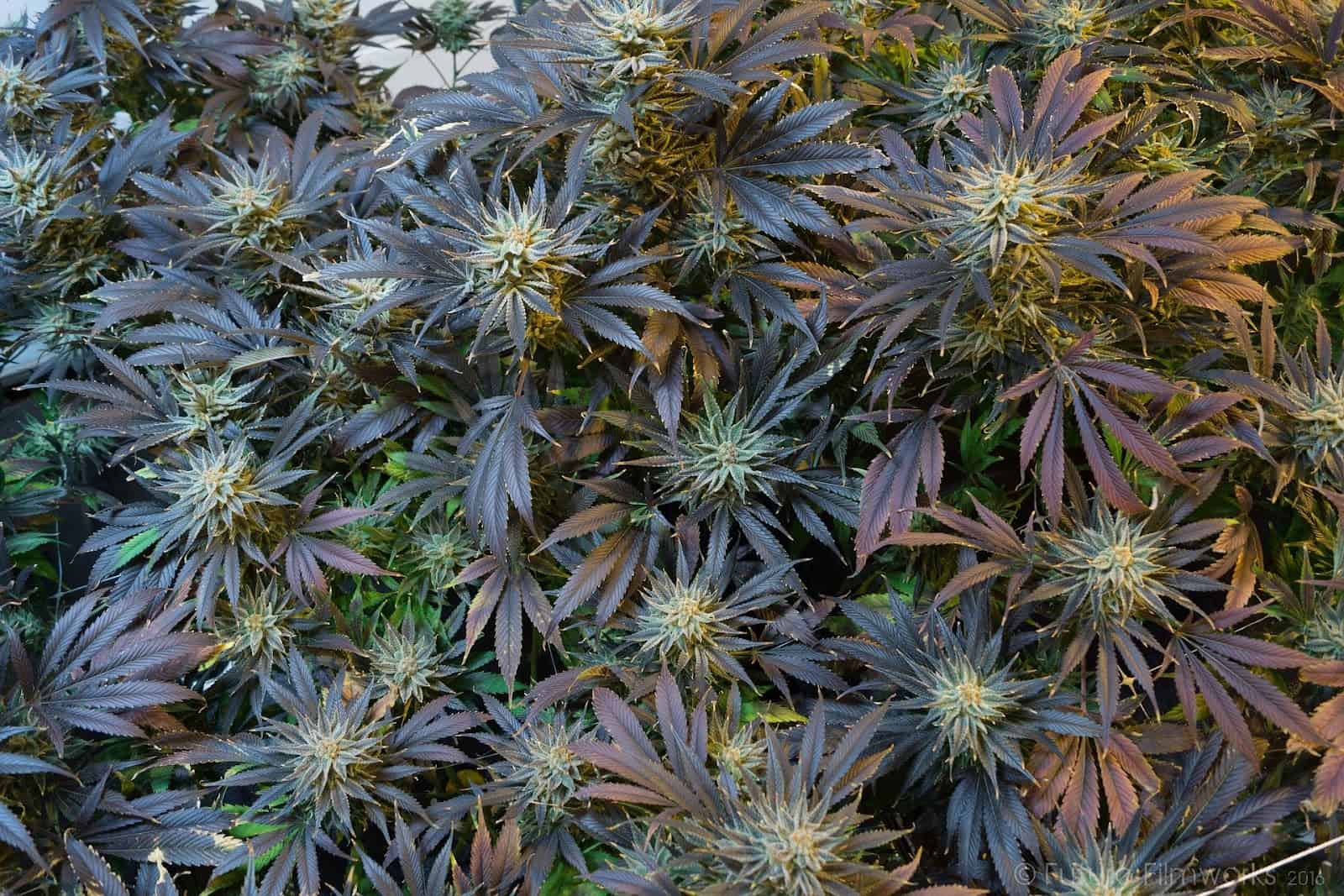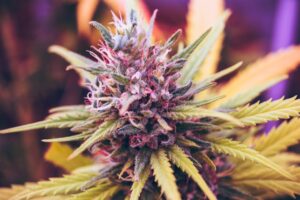Aeroponics is a revolutionary cannabis cultivation technique that involves suspending cannabis roots and supplying nutrients directly via mist. This growing method produces higher yields and faster growth than standard soil cultivation.
Setting up an aeroponic system may seem complex, but it uses less water and reduces soil-borne pests and diseases. Success depends on good maintenance, and knowing potential roadblocks helps you troubleshoot. Explore this cultivation method to find various strategies to maximize your cannabis farm.
Aeroponics can transform your cannabis growing experience and help you produce high-quality cannabis sustainably. With the right information and resources, you may achieve great results and enjoy your hard work.
Key Takeaways
- Aeroponics grows cannabis swiftly and efficiently.
- Aeroponic systems provide several benefits despite being a bit complex to set up and maintain.
- Being aware of challenges might improve your cultivation methods.
Basics of the Aeroponics System
Aeroponics is a unique cultivation method that involves growing plants in air or mist, without soil. Understanding its key features can help you decide if this is the right growing system for your needs.
Difference Between Aeroponics and Hydroponics
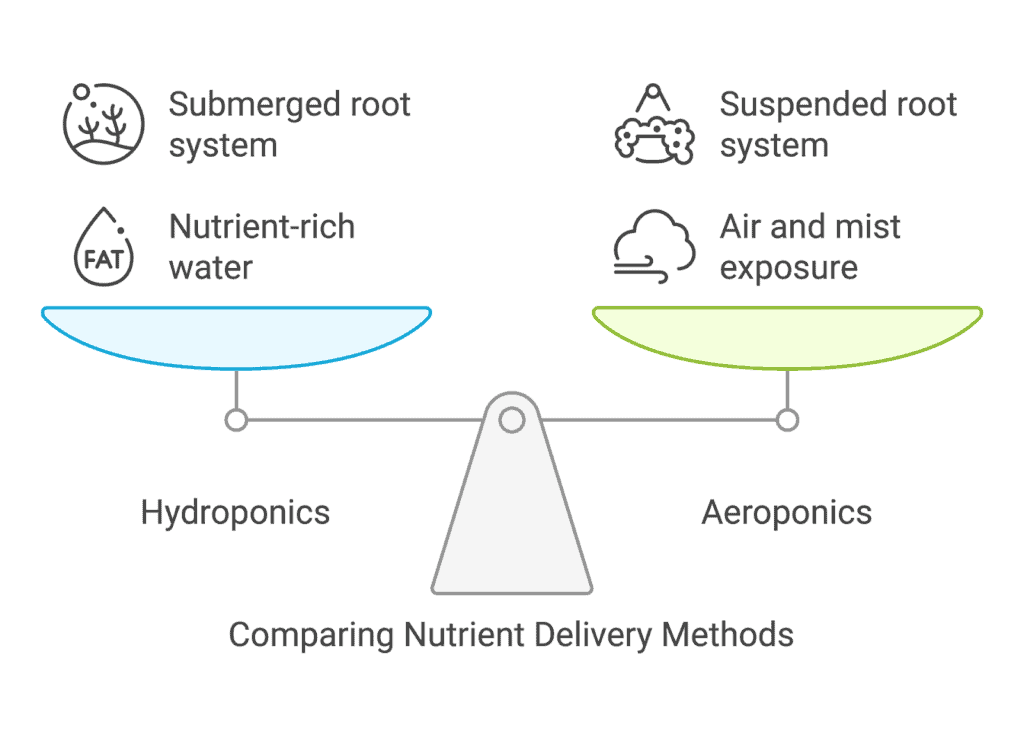
Hydroponics and aeroponics use soilless cultivation methods but work differently. Hydroponics grows plants in nutrient-rich water. Roots can easily absorb nutrients because they are immersed or partially submerged in a reservoir containing a special solution.
However, aeroponics suspends roots in the air and sprays them with water-nutrient solution regularly. Oxygen exposure gives roots more air, accelerating growth. Both methods eliminate soil, but aeroponics optimizes oxygenation more actively.
Understanding the Aeroponic System
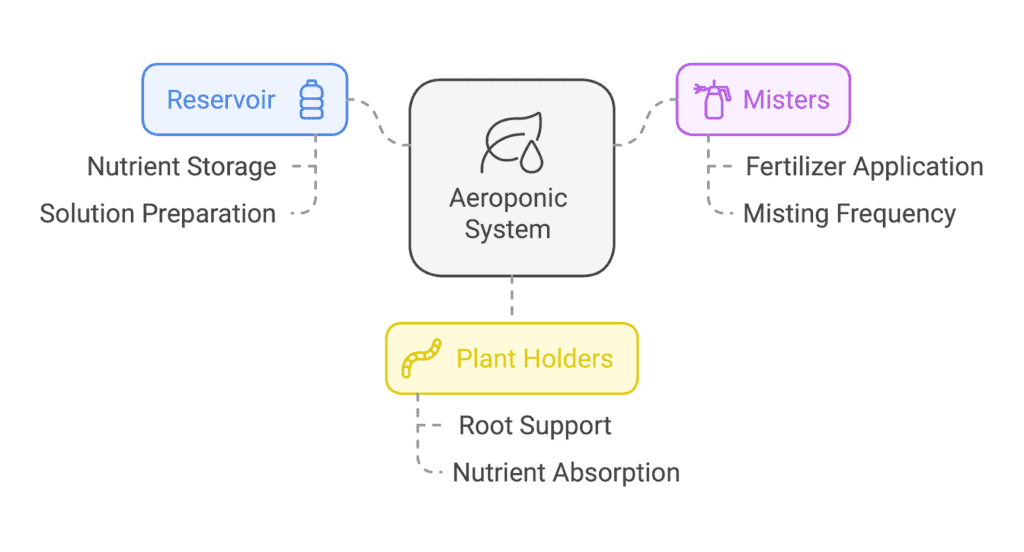
Aeroponic systems improve growth and efficiency using several elements. The most crucial part is the mist delivery system, which sprinkles plant roots with nutrients.
This setup requires no soil or other growing media. The roots directly absorb nutrients and moisture while dangling. This method improves moisture and nutrient control.
Aeroponics’ fundamental components are:
- Reservoir: This holds a nutrient solution.
- Misters: Spray roots with fertilizer solution occasionally.
- Plant holders: Allow roots to absorb nutrients while holding plants in place.
These components can create a fertile atmosphere for rapid plant growth.
Benefits of Aeroponic Cannabis Cultivation

Aeroponics benefits cannabis cultivators since it promotes rapid growth and resource efficiency, making this method appealing to both rookie and experienced growers. The main benefits of aeroponic cannabis growth are:
Faster Growth and Yield
Aeroponic systems grow cannabis faster than conventional ones. Continuously fed and watered plants are healthier.
Some grow cannabis in shorter vegetative periods. This can result in quicker transitions to the flowering stage. Thus, you may get more yields faster. Increased oxygen levels at the root zone also contribute to robust plant development.
Many growers say their plants produce more cannabinoids and grow faster. This method yields stronger plants with more flowers, which appeals to serious growers.
Decreased Water and Nutrient Use
Water and nutrients are efficiently employed in aeroponic cannabis growth. Aeroponic systems require 90% less water than soil-based cultivation at larger volumes. The misting procedure helps the roots absorb every droplet.
Thus, resource use is greatly decreased. Since nutrients are delivered where and when needed, waste is reduced. Plants only take what they need, reducing excess for growers.
This strategy reduces costs and benefits the environment. Using inputs efficiently lets you grow healthy cannabis plants on a budget. Water conservation promotes sustainable farming.
Setting Up Your Aeroponic System
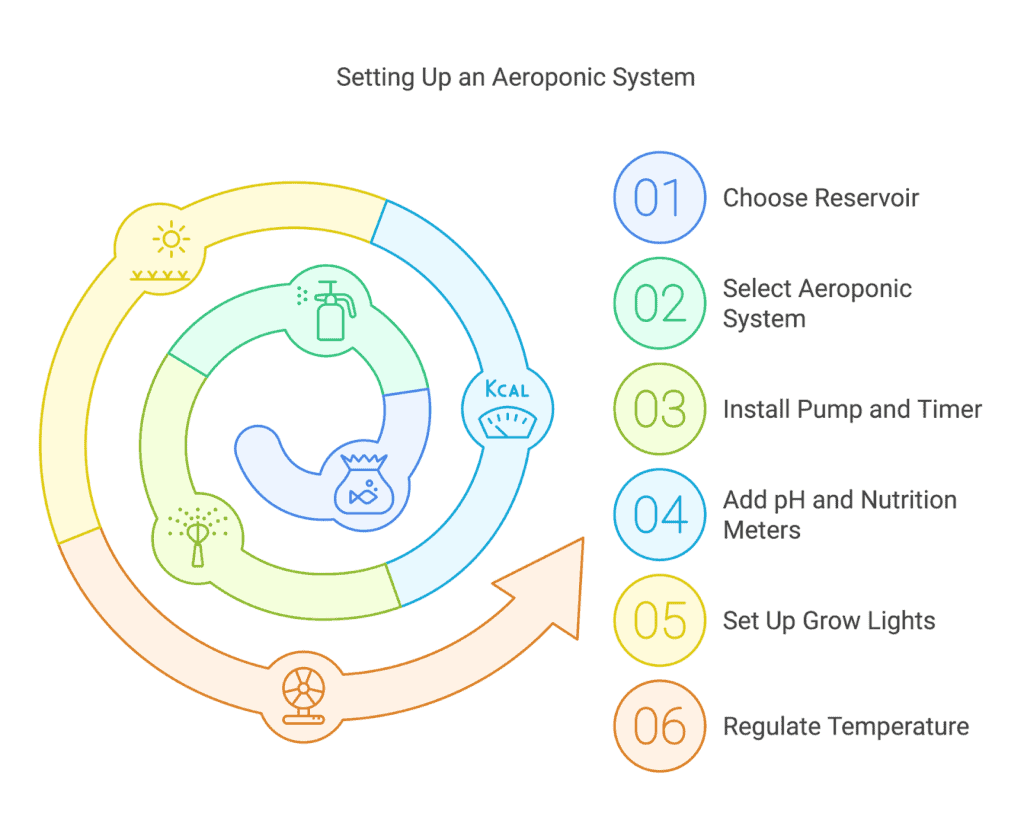
Setting up an aeroponic cannabis system requires choosing the right parts and creating the right environment. Both elements are necessary for optimal productivity and growth.
Choose the Right Components
A successful aeroponic system depends on component selection. A strong reservoir is needed to store nutritious solutions. It should store enough water for your plants and be sturdy.
Next, consider the aeroponic system itself. You can purchase premade systems or build your own using materials like PVC pipes or plastic bins. Make sure the arrangement allows root misting.
You’ll need a reliable pump to move the nutritional solution. Include a timer to control misting frequency. Finally, invest in pH and nutrition meters to provide your plants with the best care.
Create the Perfect Environment
Light, temperature, and humidity all be considered when setting up your cannabis plants. Grow lights ensure plants get enough light indoors. Aim for 18 hours of light during the growth phase.
It’s crucial to regulate temperature. Growing temperatures should be 70°F to 85°F. If it’s too hot, use fans or AC.
Humidity control is also essential. Between 40% and 60% humidity is good for vegetative growth. A hygrometer can measure humidity and a humidifier or dehumidifier can adjust it. This precise balance will boost plant root systems and yield a superior crop.
Maintaining Your Aeroponic Growth
Your aeroponic system needs adequate care to grow healthy cannabis plants. Controlling the root system and monitoring nutritional solutions are required. These methods dramatically affect plant development and productivity.
Monitoring and Adjusting Nutrient Solutions
Check the nutrient solution often to keep cannabis plants healthy. For aeroponics, 5.5–6.5 pH is ideal. Use a pH meter to check your solution frequently.
Check nutritional concentrations. Use a Total Dissolved Solids (TDS) meter to measure solution strength. Cannabis grows best at 800-1200 ppm.
Adjust fertilizer as plants grow. Older plants need more nutrients than younger ones. Freshen the solution every one to two weeks to prevent nutrient accumulation and root rot.
Managing the Root System
Cannabis root systems develop best in aeroponic settings with continuous airflow. Check roots periodically for firmness and whiteness, which indicate health.
Keep water at 65–70°F. Warmer water can lower oxygen levels, affecting root health. Use a rooting gel or solution to promote root growth if roots are stressed.
Clean the aeroponic system every two weeks. Preventing blockages and algae growth strengthens roots and promotes plant growth.
Challenges and Solutions in Aeroponic Cannabis Cultivation

Aeroponic cannabis growth has pros and cons. Knowing and addressing these challenges can boost growth and yields.
Handling Diseases and Pests
Aeroponic cannabis plants can be damaged by aphids, spider mites, and whiteflies, therefore regular inspections are needed. Look for webbing or discolored foliage to indicate infestation.
Neem oil and non-toxic insecticides are great natural options. Apply these treatments early in the morning or late at night to protect beneficial insects.
Root rot can result from overwatering or poor aeration. Maintain enough airflow around system roots. Cleanliness helps prevent disease. Regularly clean the reservoir and remove dead plants to reduce health risks.
Fixing Common Issues
- Aeroponic cannabis farms often have pump failures and nutrient shortages. Nutrient difficulties often result from unbalanced solutions. Check and modify the nutrient mix regularly.
- Root rot is another issue. Maintain proper air and water systems for healthy roots. Mushy or brown roots may suggest root rot.
- Pump failures dry roots quickly. Invest in a reliable pump and plan. Prevent unexpected plant stress with this. Monitoring systems can spot pump issues before they harm plants.
A proactive approach to these concerns can improve your aeroponic cannabis growing experience.
Bottom Line
In conclusion, aeroponics offers an innovative and efficient way to grow cannabis, providing faster growth rates, higher yields, and significant resource savings compared to traditional methods. While the setup and maintenance require careful planning and consistent monitoring, the benefits of a well-managed aeroponic system make it a worthwhile investment for serious growers. By addressing challenges proactively and optimizing your system, you can cultivate healthier plants and achieve exceptional results in cannabis production.
Frequently Asked Questions on How To Grow Cannabis with an Aeroponics System
What are the essentials for aeroponic cannabis production?
Some items are needed to build up an aeroponic system. These include a timer, air pump, nutrient reservoir, and misting chamber. A pH meter and humidity controls are useful. These aeroponics elements make the perfect cannabis plant environment.
How do hydroponic and aeroponic cannabis plant yields and quality differ?
Aeroponic systems produce more than hydroponic ones. Increased oxygen exposure at the roots speeds growth. Aeroponics improves cannabis quality by controlling moisture and nutrients more accurately.
What fertilizer mixture is recommended for aeroponic cannabis plants?
For cannabis in an aeroponic system, use a nutrient mix designed for hydroponics. Select one with greater phosphate, potassium, and nitrogen throughout the blooming and vegetative stages. To ensure proper nourishment, check pH levels regularly.
How often should cannabis roots be misted in aeroponics for maximum results?
Spray roots every 5–10 minutes during the light cycle. Adjust frequency to plant size, temperature, and humidity. Proper misting ensures roots get adequate moisture and nutrients to grow well.
What problems do aeroponic cannabis growers face?
Maintaining optimal humidity and nutrition balance are common issues. Misting system failure can cause root dryness. Monitor environmental and technical conditions to avoid these issues.
What are the long-term costs and maintenance of an aeroponic cannabis business?
Initial setup, pump electricity, and fertilizer replenishment are long-term costs. Maintenance includes system cleaning and pH and nutrient monitoring. Budget for new parts to keep your system running well.

